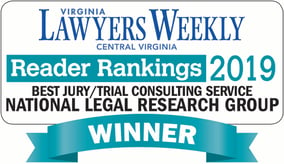February 8, 2018

So far, our Tips series has focused on setting the stage for effective voir dire (Tip 1; Tip 2; and Tip 3), capitalizing on open-ended questions to increase our understanding of jurors (Tip 4), and avoiding the “looking good” bias (Tip 5). Our next tip addresses potential “bad” answers and how to use them to ask better questions and get better overall results. (Click here to see a short video for this tip.)
Bad Answers
Our goal in jury selection is to identify potentially unfavorable jurors whom we need to remove either through challenges for cause or peremptory challenges. The unfavorability of jurors is primarily based on their having opinions and values that would lead them to view your client’s case negatively or, conversely, to view your opponent’s case positively. While jurors certainly may have had relevant negative experiences or work experiences in areas unfavorable to a client, our attention here is on the jurors’ unfavorable opinions and values themselves. That is, we look for the unfavorable opinions and values, what we term “bad” answers, as reflected in what jurors tell us during voir dire (or on supplemental juror questionnaires). The following are a few of the topic areas where “bad” answers are likely found:
Civil area:
- Opinions on civil lawsuits
- Opinions on damages, in general
- Viewpoints concerning the elements of damages
- Perceptions of the credibility of key “types” of witnesses (e.g., doctors or psychiatrists)
- Viewpoints on the type of case being tried (e.g., medical negligence, personal injury, or patents)
- Standard(s) of proof
- Predisposition for a certain verdict or leanings based on pretrial publicity or other factors
Criminal area:
- Opinions on the causes of crime
- Viewpoints on the goals of punishment or criminal sentencing
- Viewpoints on the elements of the alleged crime
- Perceptions of the credibility of key “types” of witnesses (e.g., police or FBI)
- Viewpoints on the type of case being tried (e.g., rape or sexual assault, capital punishment, or police misconduct)
- Opinions concerning legal principles, evidence, or standards (e.g., presumption of innocence, right of the defendant not to testify, circumstantial evidence, or no requirement to show motive in certain cases)
- Standard of proof
- Predisposition for a certain verdict or leanings based on pretrial publicity or other factors
While the above list suggests various potential areas, it is not exhaustive. All cases have unique characteristics and dynamics that become fertile ground for our inquiry into bad answers.
Identifying Potential Bad Answers
The search for potential bad answers starts with the attorneys’ personal experiences. What have jurors said during past jury selections that would lead you to say, “If jurors said (bad or unfavorable opinion) during voir dire, I would remove them.” But our search doesn’t end there; “bad” answers can be found in the results and in jurors’ comments found in empirical research (e.g., focus groups, mock trials, or surveys), either conducted as part of litigation efforts or conducted/reported by other entities (e.g., media reports on polling). In addition, social media comments to stories or posts relevant to your case (or similar cases) can be a valuable source of negative or bad answers. Examples of potential bad answers or phrases include:
“Punitive damages do more harm than good.”
“If it’s not in the medical record, it didn’t happen.”
“Giving money for the death of someone doesn’t seem right since it won’t bring that person back.”
“If a defendant does not take the stand, he/she must be guilty.”
“I have a problem with convicting someone based on circumstantial evidence.”
Crafting the “Bad” Answer Question
The key to uncovering unfavorable jurors is to come prepared to explore bad or negative views—even when not raised by jurors. Sure, bad answers may arise on their own during questioning. However, as often happens in group-conducted voir dire, jurors can be reluctant to volunteer some of these bad answers. The previously discussed tips (such as using open-ended questions, Tip 4) are very useful in uncovering bad answers or opinions. But we cannot stop there. Addressing a particular topic and receiving no bad answers doesn’t mean that some of the potential jurors questioned do not harbor undesirable opinions or values. In such circumstances, before leaving the topic at issue, ask jurors directly if they would endorse unfavorable or bad answers. Consider some of the following questions that are crafted based on the bad answers raised above:
“How many of you feel that punitive damages do more harm than good?”
“How many of you feel that if it’s not in the medical record, it didn’t happen?”
“A juror once told me, ‘You know, I just don’t believe in providing money to relatives of someone who is killed in a traffic collision. Money won’t bring the person back.’ How many of you tend to feel the same way?”
“How many of you feel that if the defendant does not testify, he is probably guilty?”
“How many of you feel that you would have any problems or reservations in convicting a defendant based on circumstantial evidence?”1
Wait . . . Are You Crazy?!
Some may question the wisdom (or sanity) of my recommendation that attorneys address unfavorable viewpoints or values, even when not raised by jurors. However, there are several reasons for making this recommendation. First, just because jurors do not volunteer unfavorable opinions (bad answers) doesn’t mean that they don’t have them. Putting jurors on the spot and addressing unfavorable opinions and values increases the likelihood that potentially unfavorable jurors will admit to holding them. Second, phrasing the questions to directly address bad answers can remove some of the ambiguity surrounding more general questions or open-ended responses. Hence, again, this increases the likelihood that critical jurors will admit to holding these unfavorable opinions. Third, raising negative viewpoints, as is accomplished in this approach, is not going to “infect” or change jurors’ minds. The kinds of bad answers addressed tend to be on the more extreme ends of the opinion spectrum. As such, jurors are not likely to disregard their own opinions and adopt an extreme viewpoint simply at the mention of this position. Finally, any concern for infection of the panel ignores the fact that such negative positions may be raised by the opponent or by other jurors during deliberations. Either way, identifying those jurors sympathetic to “bad” answers will improve your effectiveness in jury selection.
You can’t leave it to chance (or to the whims of jurors) that critical “bad” answers will spontaneously appear during questioning. Crafting and asking questions with the bad answers in mind helps identify unfavorable jurors and will decrease the chance of these potentially “bad” jurors getting on your jury.
We will be covering additional tips in the months to come. Check out our introductory two-minute video, Tip 1, Tip 2, Tip 3, Tip 4, Tip 5, and the video for Tip 6.
1For more information on voir dire and jury selection, see Mastering Voir Dire and Jury Selection: Gain an Edge in Questioning and Selecting Your Jury (2018). Also, check out my companion book on supplemental juror questionnaires, Mastering Voir Dire and Jury Selection: Supplemental Juror Questionnaires (2018).
__________________________________
1For a further discussion, see Mastering Voir Dire and Jury Selection: Gain an Edge in Questioning and Selecting Your Jury (2018).



